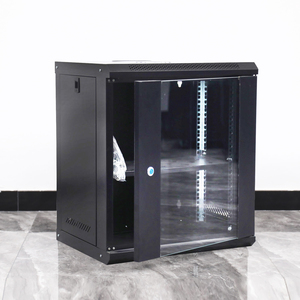
All categories
Featured selections
Trade Assurance
Buyer Central
Help Center
Get the app
Become a supplier

(3872 products available)












































A 9U network cabinet is a storage cabinet for IT equipment. The letter ""U"" means rack units. One U equals 1.75 inches in height. The 9U network cabinet has a height of 9 inches. It is small and compact. Depending on the size and type of network equipment, it can store up to 25 pieces of network equipment. A 9U network cabinet is ideal for small office spaces and home offices. Depending on the application or setting, there are several types of 9U network cabinets, which include;
Standardization and Modularity:
The structured cabling uses standardized materials and installation methods. It follows a modular design that can be expanded, allowing for future upgrades and modifications.
Defined Spaces for Communication and Equipment Rooms:
It provides defined spaces for all telecommunications cables and equipment to be housed. It consists of telecommunication rooms, equipment rooms, and a horizontal cabling area.
Vertical and Horizontal Cabling:
A nine-u network cabinet offers both vertical and horizontal cabling options, which integrate with open office layouts and accommodate both wired and wireless setups.
Cable Management:
The cabinet features cable management capabilities that help maintain an organized and neat wiring arrangement to ensure proper airflow and easy cable identification and troubleshooting.
Access and Security:
9U network cabinets have keylock or electronic locks to safeguard sensitive network equipment. They also have removable side panels and doors to enable easy access for maintenance while protecting against unauthorized entry.
Network cabinets have diverse applications across multiple industries and sectors. Some may include;
Space and Equipment Needs:
Buyers first assess how much space is available. They measure the area where the cabinet will go. Then, they check how much network equipment they have. This includes counting switches, routers, and servers. Looking at these two factors, the workspace, and how many pieces of equipment, helps buyers determine the appropriate number of network cabinets needed and their required size. Also, considering what extra network equipment they may add in the future can assist in choosing cabinets that will suit their needs for a longer time.
Cooling and Airflow:
Cooling is really important. The network equipment gives off heat when it works. If a cabinet traps the heat inside, it can make the equipment overheat. That is why good air circulation is a must. Air should be able to easily move in and out of the cabinet freely. To help keep cool, Network cabinets must have enough fans too. Fans can help air circulate better. Proper cooling and airflow prevent overheating, ensuring the equipment runs without problems.
Mounting Type:
Choose between a rack-mounted or shelf-mounted network cabinet. A rack-mounted cabinet secures the network gear to vertical racks. It saves space because the network devices stay inside the cabinet, neatly organized from top to bottom. A shelf-mounted cabinet places the network devices on horizontal shelves. This type is easier to set up, but it takes up more floor space. A rack-mounted is the better option for larger amounts of equipment or limited floor space. A shelf-mounted works well for smaller networks or where space is not an issue.
Accessibility and Security Measures:
Look for cabinets in convenient places. These allow users to quickly get to the network equipment when needed. Network gear needs protection too. Consider cabinets with lock doors to secure sensitive information. Doors with strong materials also help keep intruders out. Accessible, well-protected network cabinets safeguard important data while allowing easy equipment access.
Shelves and Capacity:
Buyers ought to check if the cabinet has enough shelves to hold all their equipment. They also need to make sure it can hold the weight of what is being put inside. Following that, they ought to examine if the shelf size matches their network equipment which is important because gear needs room to fit.
Q1: What equipment can a 9U server cabinet hold?
A1: A 9U network cabinet can accommodate servers, network switches, patch panels, audio and video equipment, storage devices, and other 9U rack-mounted hardware essentials.
Q2: What are the benefits of using a 9U rack mount cabinet?
A2: The 9U rack provides a neat arrangement for all rack-mounted equipment. It also saves space, as the cabinet is designed to minimize real estate without sacrificing security and accessibility. Furthermore, the 9U cabinet offers physical protection to sensitive equipment.
Q3: What is the difference between open frame racks and racks with cabinets enclosures?
A3: Open frames provide a basic structure without sides or a top. They are ideal for equipment that needs to be easily accessible. Enclosed cabinets have the rack-mounted equipment housed inside and provide security and access through locked doors.
Q4: How much weight can a 9U rack mount cabinet hold?
A4: The weight capacity depends on the type of 9U network rack. For instance, a 9U wall mount cabinet weighs between 25 and 40 kgs, but the weight capacity can be higher depending on the manufacturer. On the other hand, a 9U open frame rack can hold between 50 and 250 kgs. The weight capacity also varies based on the manufacturer specification.
Q5: What is the depth of the 9U cabinet?
A5: The cabinet depth can be shallow, deep, or standard. A shallow 9U network cabinet has a depth of not more than 12 inches (30.5 cm), a deep one has a depth of over 30 inches (76.2 cm), and a standard cabinet has a depth of between 0.5 and 1 meter (1.64 to 3.28 feet). The appropriate depth depends on the equipment to be stored.